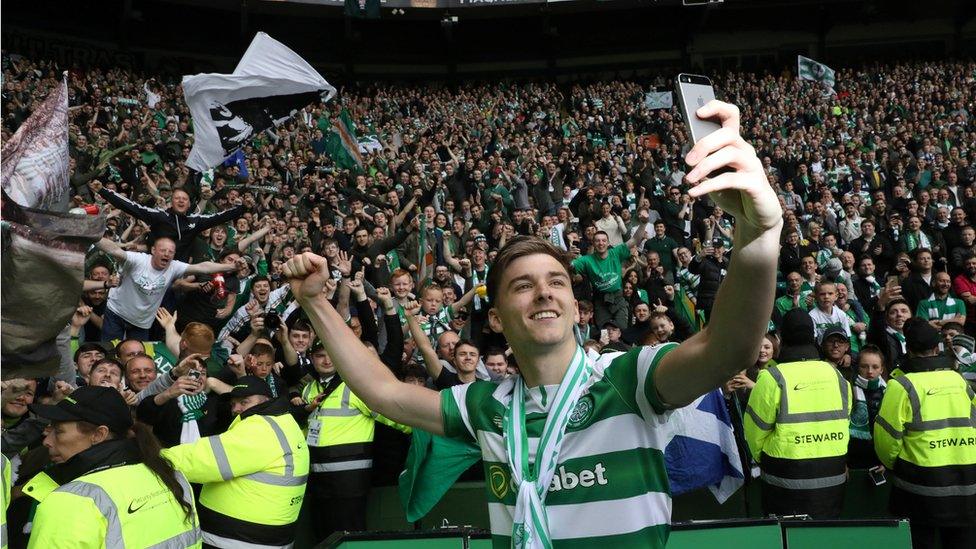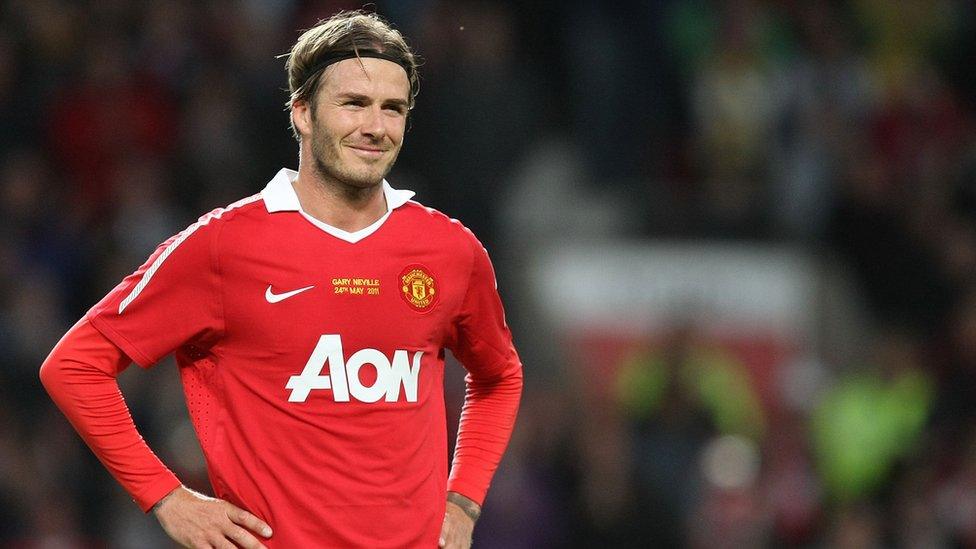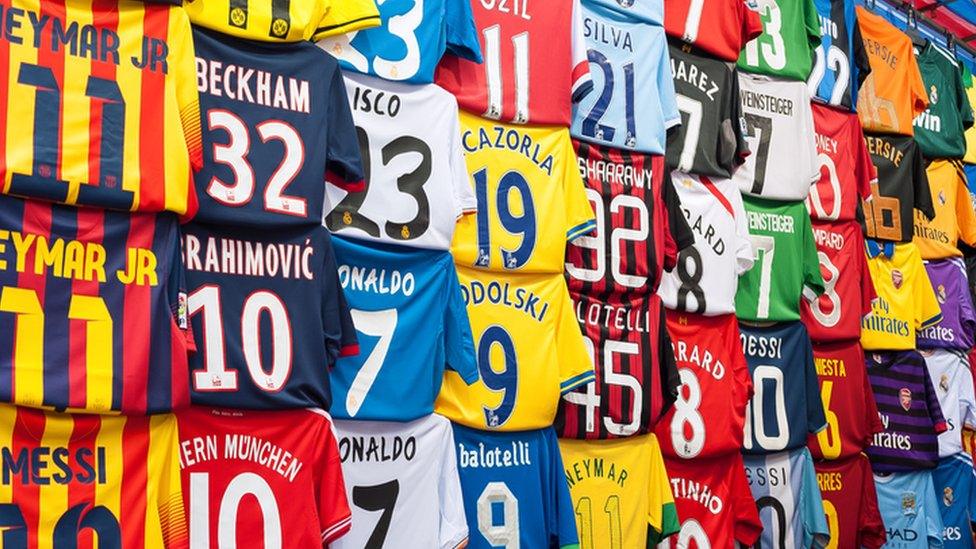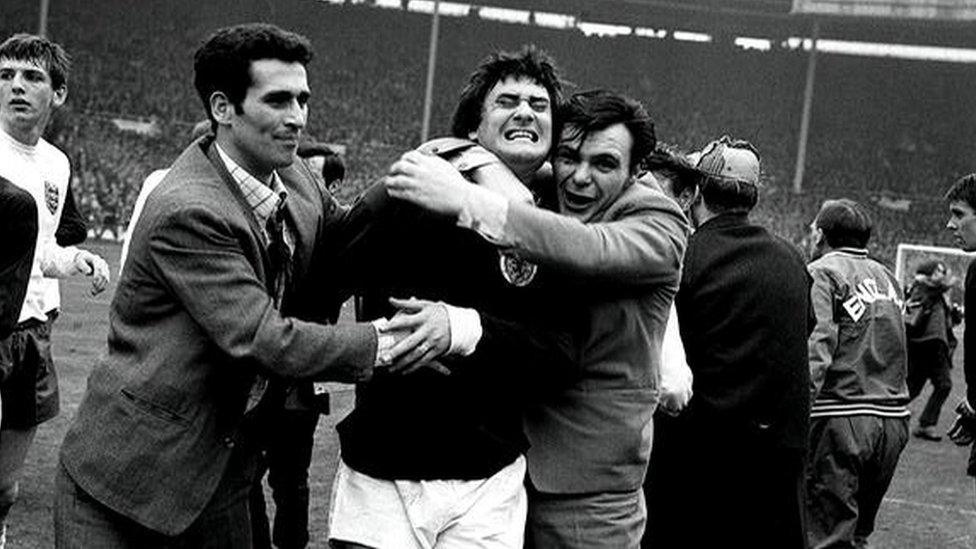How to spot a sports memorabilia fake
- Published

Kieran Tierney told a fan that he still owned the shirt that had been put up for sale
Celtic starlet Kieran Tierney hit the headlines earlier this week, after he stepped in to stop a fan making a very expensive mistake.
The supporter was considering spending £175 on a shirt he thought Tierney wore during Celtic's 3-3 draw with Manchester City in the Champions League.
But when he contacted the 19-year-old full back on social media, the player replied saying he still owned the shirt and it was likely to be a scam, the Daily Record reported, external.
Experts claim the sports memorabilia market has been flooded with thousands of fakes in recent years.
Auctioneer David Convery and Det Sgt Kevin Innes told The Stephen Jardine Programme on BBC Radio Scotland how to spot the genuine article.


One shirt signed by David Beckham - that he hadn't even worn - sold for £27,000
How big is the market for sports memorabilia?
Mr Convery, a sports memorabilia expert from Great Western Auctions in Glasgow, said the market is huge.
"I've been selling sporting items since 1987," he said. "I've seen the market grow and grow especially since the advent of the internet."
But he reckons 90% of items that are sold at charity auctions or online are a "fake or a copy" - very few are authentic match-worn shirts.
"At the start of every week, the majority of the big clubs will farm out 40 to 50 replica shirts signed by the team to various good causes, charity," he said.
"The majority of the time, people are buying a replica signed shirt. There are very few genuine shirts that are actually out there to be bought on the market."
He said he knows of one shirt signed by David Beckham, which was sold at a charity auction for £27,000 - even though it had never touched his back.
"It's fantastic for the charity," he said. "But in the real market it is only worth about £70."
Earlier in his career, Mr Convery said he sold the shirt worn by Jim Baxter during Scotland's 1967 win over England.
But he fears there are many copies of the historic item.
"I've seen subsequent shirts selling as being worn by Jim Baxter on that particular day when we became unofficial world champions," he said.
"However, he had the only shirt and I sold it. All the other ones - be wary. "


What are the tell take signs of fake goods?
Price should be the first indicator of authenticity, according to both Mr Convery and Det Sgt Kevin Ives, of the City of London Police intellectual property crime unit (PIPCU),
"If you're buying online, I'd echo the old cliche - if it looks to good to be true, then it probably is," said Det Sgt Ives.
He also urged buyers to be wary of the websites that they're using.
He said: "My unit shut down over 23,000 of these counterfeit goods websites since 2013.
"Some of the trends that we've noticed is that these are not run by people in the UK, so you can look out for spelling or grammatical errors.
"The websites will take longer to load up on screen and some of the hyperlinks won't work."
Mr Convery suggested that people looking for match-worn shirts check out the sleeve length preferred by particular players as well as the badges used.
"Really, for a professional like myself, I need to touch it," he said.
"Material is very important - professional footballers like good, breathable material... if it's not the same material, just be wary."
He also likes to check the provenance of goods, preferring to buy from a trusted dealer or family of the sports person in question.
"The bulk of the modern stuff I see these days - and I see a lot of stuff, the majority of which I turn away - I just don't like the provenance, I can't guarantee it."


Experts fear there are many copies of the shirt worn by Jim Baxter at Scotland's 1967 win over England
What is the impact of buying fakes?
Det Sgt Ives said the sale of counterfeit goods affects jobs and industry in the UK - but it can also put the personal details of the buyer at risk.
"There's actually a real danger to the people buying these goods," he said.
"What can happen, and does happen a lot, is that if you buy these goods from a counterfeit website, the website needs people's fake details to open up new websites when they've been shut down.
"We've had people who have bought a pair of trainers and ended up with 500 counterfeit goods websites opened up in their name.
"And that opens you up to lots of issues because if the next person realises their goods are counterfeit, it's your name and address behind the website."
Some goods may also be shoddily made and even dangerous, he warned.

If you have been conned, what can you do?
If buyers have used online market places like Ebay and Amazon, they should report report it to them, said Det Sgt Ives.
"Generally speaking they are pretty good at following the dispute," he said.
The police officer also recommended buyers get in touch with their credit card company, if that has been used to purchase the product, as they may be able to help obtain a refund.
He added: "I would urge people to report these things to the police if there's a counterfeit seller or to their local trading standards."